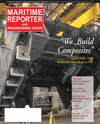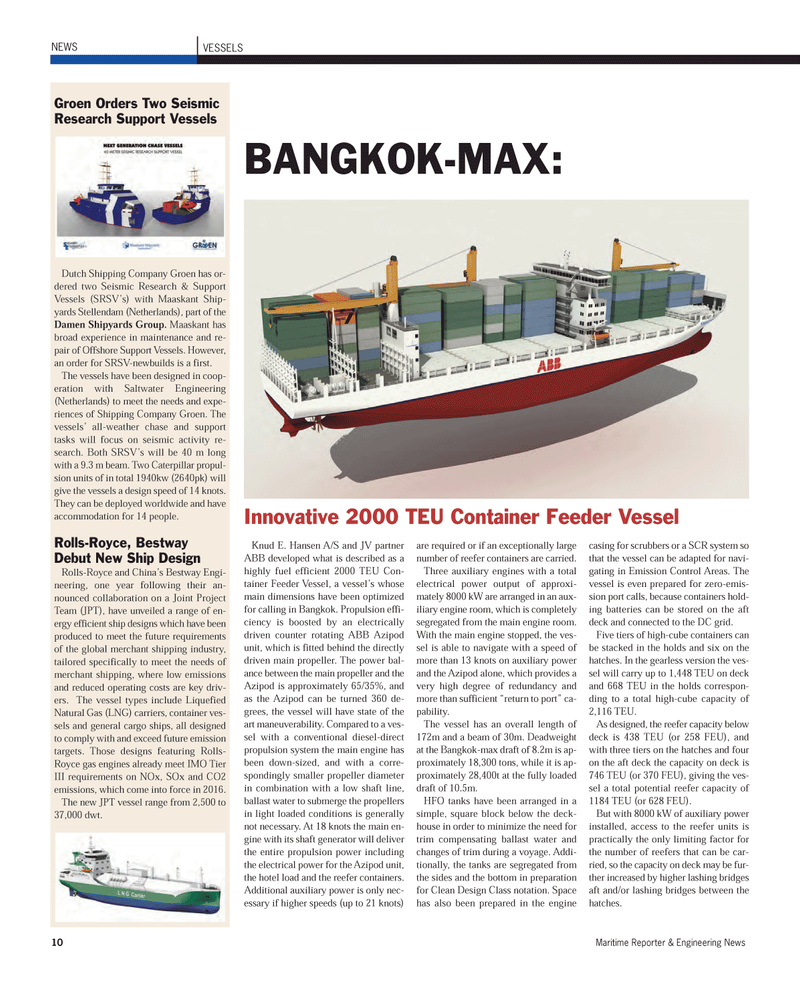
Page 10: of Maritime Reporter Magazine (January 2012)
US Navy Report
Read this page in Pdf, Flash or Html5 edition of January 2012 Maritime Reporter Magazine
10Maritime Reporter & Engineering News NEWSVESSELSGroen Orders Two Seismic Research Support Vessels Dutch Shipping Company Groen has or- dered two Seismic Research & Support Vessels (SRSV?s) with Maaskant Ship- yards Stellendam (Netherlands), part of theDamen Shipyards Group. Maaskant hasbroad experience in maintenance and re- pair of Offshore Support Vessels. However, an order for SRSV-newbuilds is a first. The vessels have been designed in coop- eration with Saltwater Engineering (Netherlands) to meet the needs and expe- riences of Shipping Company Groen. The vessels? all-weather chase and support tasks will focus on seismic activity re- search. Both SRSV?s will be 40 m long with a 9.3 m beam. Two Caterpillar propul- sion units of in total 1940kw (2640pk) willgive the vessels a design speed of 14 knots. They can be deployed worldwide and have accommodation for 14 people.Rolls-Royce, BestwayDebut New Ship DesignRolls-Royce and China?s Bestway Engi- neering, one year following their an- nounced collaboration on a Joint ProjectTeam (JPT), have unveiled a range of en- ergy efficient ship designs which have been produced to meet the future requirementsof the global merchant shipping industry, tailored specifically to meet the needs of merchant shipping, where low emissions and reduced operating costs are key driv- ers. The vessel types include Liquefied Natural Gas (LNG) carriers, container ves- sels and general cargo ships, all designed to comply with and exceed future emission targets. Those designs featuring Rolls- Royce gas engines already meet IMO Tier III requirements on NOx, SOx and CO2emissions, which come into force in 2016. The new JPT vessel range from 2,500 to 37,000 dwt.Knud E. Hansen A/S and JV partner ABB developed what is described as a highly fuel efficient 2000 TEU Con- tainer Feeder Vessel, a vessel?s whose main dimensions have been optimized for calling in Bangkok. Propulsion effi- ciency is boosted by an electrically driven counter rotating ABB Azipod unit, which is fitted behind the directly driven main propeller. The power bal- ance between the main propeller and theAzipod is approximately 65/35%, andas the Azipod can be turned 360 de- grees, the vessel will have state of the art maneuverability. Compared to a ves- sel with a conventional diesel-direct propulsion system the main engine hasbeen down-sized, and with a corre- spondingly smaller propeller diameterin combination with a low shaft line, ballast water to submerge the propellers in light loaded conditions is generallynot necessary. At 18 knots the main en- gine with its shaft generator will deliver the entire propulsion power including the electrical power for the Azipod unit, the hotel load and the reefer containers.Additional auxiliary power is only nec- essary if higher speeds (up to 21 knots)are required or if an exceptionally large number of reefer containers are carried.Three auxiliary engines with a totalelectrical power output of approxi- mately 8000 kW are arranged in an aux-iliary engine room, which is completelysegregated from the main engine room. With the main engine stopped, the ves- sel is able to navigate with a speed of more than 13 knots on auxiliary power and the Azipod alone, which provides a very high degree of redundancy and more than sufficient ?return to port? ca- pability. The vessel has an overall length of 172m and a beam of 30m. Deadweightat the Bangkok-max draft of 8.2m is ap- proximately 18,300 tons, while it is ap-proximately 28,400t at the fully loadeddraft of 10.5m.HFO tanks have been arranged in a simple, square block below the deck- house in order to minimize the need fortrim compensating ballast water and changes of trim during a voyage. Addi- tionally, the tanks are segregated from the sides and the bottom in preparationfor Clean Design Class notation. Spacehas also been prepared in the enginecasing for scrubbers or a SCR system sothat the vessel can be adapted for navi- gating in Emission Control Areas. The vessel is even prepared for zero-emis- sion port calls, because containers hold-ing batteries can be stored on the aftdeck and connected to the DC grid.Five tiers of high-cube containers can be stacked in the holds and six on the hatches. In the gearless version the ves- sel will carry up to 1,448 TEU on deck and 668 TEU in the holds correspon- ding to a total high-cube capacity of2,116 TEU. As designed, the reefer capacity below deck is 438 TEU (or 258 FEU), and with three tiers on the hatches and fouron the aft deck the capacity on deck is746 TEU (or 370 FEU), giving the ves- sel a total potential reefer capacity of1184 TEU (or 628 FEU). But with 8000 kW of auxiliary power installed, access to the reefer units ispractically the only limiting factor for the number of reefers that can be car- ried, so the capacity on deck may be fur- ther increased by higher lashing bridgesaft and/or lashing bridges between thehatches.BANGKOK-MAX: Innovative 2000 TEU Container Feeder Vessel MR Jan.12 # 2 (10-17):MR Template 1/10/2012 10:44 AM Page 10

 9
9

 11
11
